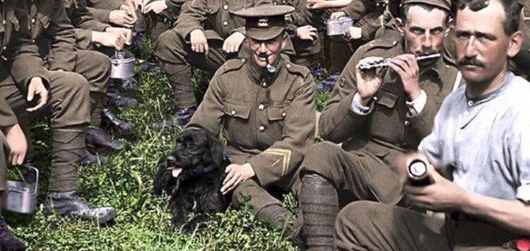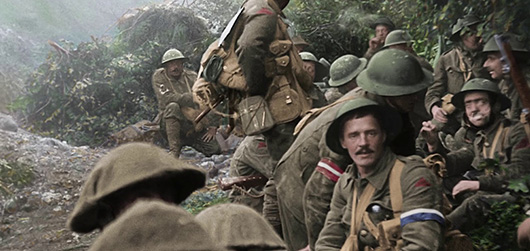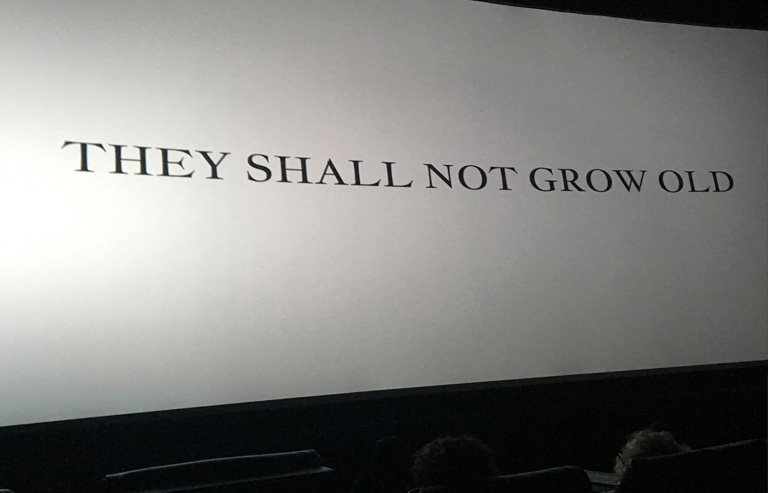Yesterday was able to snag the last local ticket to the kinda one-day-only First World War Peter Jackson passion project documentary event They Shall Not Grow Old (2018).
And it is totally a Peter Jackson thing.
They Shall Not Grow Old is an obsessive, over the top, documentary built from 100-year-old film reels from the Imperial War Museums, collected ephemera, BBC interviews and a lot of digital-enhancements – such as as taking overexposed film and pulling images from the darkness; something other filmmakers never quite tried with the same footage (adjusting curves in Photoshop is good for this).
Vintage frame rates were all over the place (original cameras were cranked by hand) so a lot of guesswork happened converting messy filmstock to today’s 24-frames-per-second standard – including Jackson vacationing to the original trenches and matching the colour of grasses and plant life.
With around 100 hours of restored black and white footage completed (and given back to the museum for its holdings), Great War (1914–18) aficionado Jackson decided to take some of these materials and tell the story of the British Infantry and their experience in the trenches.
Avoiding politics and formal causes of this global conflict, the rush to war is explained through the words of British citizens who volunteered. From their POV, things were brewing against Germany and a little war was going to be the order of the day.
The conflict started as a popular, fashionable rite of passage. Oh we’re going to fight Germany now. So signing up was the cool thing to do.
With tea. Lots of tea is consumed in this film.

Small ‘mundane’ things are covered in the soldiers’ own voices (the BBC has a huge library of WWI vets they recorded in the 1960s/70s) describing the hodge podge training, the attitudes, the horrible food, the petrol containers they drank water out of and something I’ve always wondered: Why the uniforms always seem to look funny in old photos. Cause it was a few sizes fit all situation.
One veteran noted, the boots don’t fit you, it’s that you don’t fit the boots.
The documentary has no announcing track or common subtitles – just descriptions from the men who were there. Pieced together from hundreds of interviews, the narrative is one quick edit voice after another simply talking as images supplement what we are hearing.
Jackson’s attention to detail fits this project well, though limitations both help and hurt this film. Filmmaking is limited by budget (and monies supplied through grants), what footage is available, cobbled together with still photographs and whatever voice clips that keep the story on track. The 3D effects kind of overwhelm, similar to how the world is seen through binoculars. A bit less photorealistic than it could be. I’d like to see it in 2D.
Visually, this film felt a lot like Giorgio Moroder’s 1984 rock music reconstruction of Metropolis (1927); in that one can feel the technology of the movie working overtime to tell the story.
Beyond the restorations, the soldiers have a strange look to them. This is explained in a ‘making of’ short shown after, not only were they about to go into battle; they had never seen a moving film camera before. And didn’t know how to react. Many just sit still as they would in a photographer’s portrait studio. There are a LOT of camera shy soldiers in this film and it shows.
The film takes the viewer through entering the trenches, living in the trenches and pieces together a battle that was typical of the era – and knowing this going in helps, cause to a casual viewer it could look like everyone talking was in the same unit and the whole war consisted of just one big battle.
Then it was over. And the troops return home to face friends and family who had no idea what they went through. Homefront propaganda kept the general public from knowing what the soldiers experienced. British histories of the era (published in the 1920s) are often heroic and romanticized.
This was something my father used to complain about regarding his own war experience. WWII War Department propaganda and dramatic ‘Hollywood’s Version of the War’ movies never quite got things right. And this totally warps what the general public would think about war and the horrors of war.
The example he talked about the most: Action in the North Atlantic (1943) was based on the US Merchant Marine, but when he and his shipmates were in London and saw the film, they filled the theatre with laughter – especially about Humphrey Bogart’s uniform.
Where the hell did he get that uniform??

They Shall Not Grow Old is a great introduction to trench warfare in World War I – but it only tells what it can. For mor, I recommend PBS’s The Great War and the Shaping of the 20th Century (1996) and Paul Fussell’s The Great War and Modern Memory for nuance not available to Jackson in this format.
I’ve done a lot of research about WWI over the years – amped up when I was developing the modernist ‘weapons’ of the FLOMM game – there are other things to explore in the Modern History and Design section on our Bibliography page.
I am a huge fan of history told thru contemporary media. And I like when non-documentarians make documentaries. Because the approach is different – not always great, but different. In this case, the film doesn’t have the academic depth of a Ken Burns piece – and it’s not supposed to.
I give the film 4⁄5. It is scheduled to open in limited release next year. And I hope Jackson eventually tells some of the other stories he found (the British colonies in combat, the homefront, women in the factories, etc.) while digging through the archives.
—steve mehallo
Flommist Steve Mehallo is a graphic designer, illustrator, font designer, educator, foodie and gadfly. He is the creator and founder of FLOMM!
PLEASE SUPPORT FLOMM
TIPS + DONATIONS DISCREETLY ACCEPTED
















